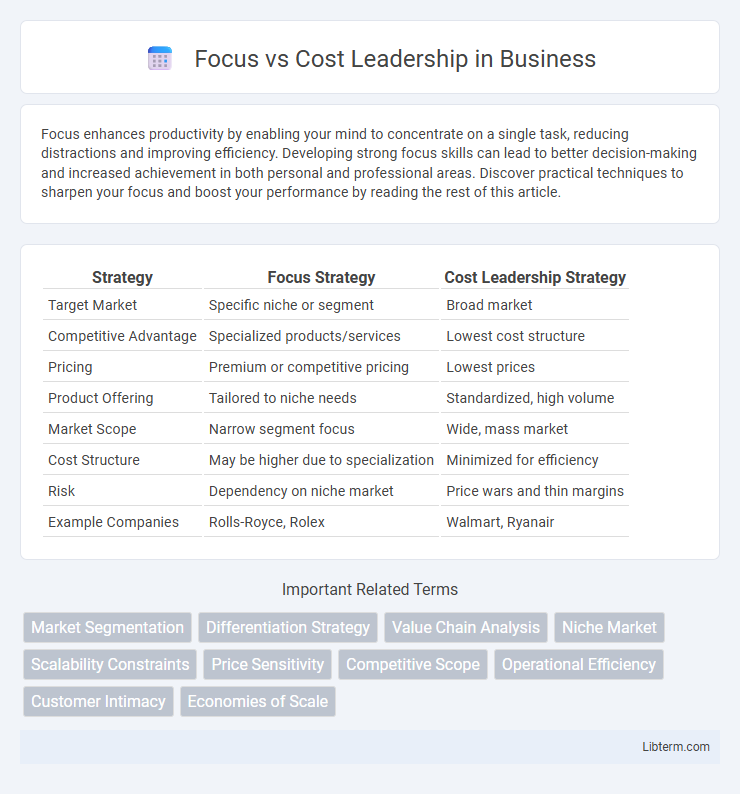Focus enhances productivity by enabling your mind to concentrate on a single task, reducing distractions and improving efficiency. Developing strong focus skills can lead to better decision-making and increased achievement in both personal and professional areas. Discover practical techniques to sharpen your focus and boost your performance by reading the rest of this article.
Table of Comparison
| Strategy | Focus Strategy | Cost Leadership Strategy |
|---|---|---|
| Target Market | Specific niche or segment | Broad market |
| Competitive Advantage | Specialized products/services | Lowest cost structure |
| Pricing | Premium or competitive pricing | Lowest prices |
| Product Offering | Tailored to niche needs | Standardized, high volume |
| Market Scope | Narrow segment focus | Wide, mass market |
| Cost Structure | May be higher due to specialization | Minimized for efficiency |
| Risk | Dependency on niche market | Price wars and thin margins |
| Example Companies | Rolls-Royce, Rolex | Walmart, Ryanair |
Understanding Focus vs Cost Leadership Strategies
Focus strategy targets a specific market niche, aiming to serve its unique needs with tailored products or services, ensuring deeper customer loyalty and higher margins. Cost leadership strategy emphasizes achieving the lowest production and operational costs to offer competitive pricing across a broad market, driving volume sales and market share. Understanding the distinction between these strategies enables businesses to align resources effectively, optimizing profitability through either specialized differentiation or efficient cost management.
Defining Focus Strategy in Competitive Advantage
Focus strategy in competitive advantage involves targeting a specific market niche or customer segment to deliver tailored products or services that meet unique needs more effectively than broader competitors. This approach leverages deep understanding of the chosen segment to build strong customer loyalty and command premium pricing. Organizations employing focus strategy concentrate resources on specialized offerings, differentiating themselves through customization, superior quality, or exceptional service.
Key Principles of Cost Leadership
Cost Leadership revolves around achieving the lowest operational cost within an industry by optimizing production processes, leveraging economies of scale, and minimizing overhead expenses. Key principles include rigorous cost control, efficient resource utilization, and aggressive pricing strategies to attract cost-sensitive customers. Companies adopting this strategy often invest in advanced technology and streamline supply chains to maintain a competitive advantage while sustaining profitability.
Major Differences: Focus vs Cost Leadership
Focus strategy targets a specific market niche by tailoring products or services to meet the unique needs of that segment, emphasizing differentiation and customer loyalty. Cost leadership strategy aims to achieve the lowest production and operational costs industry-wide, enabling competitive pricing and broader market appeal. Major differences lie in scope--focus targets narrow segments while cost leadership pursues broad market dominance--and in strategic objectives, with focus emphasizing specialization and cost leadership prioritizing efficiency and scale.
Benefits of Implementing Focus Strategy
Implementing a focus strategy enables businesses to target niche markets effectively, enhancing customer loyalty and satisfaction through specialized offerings. This strategic approach minimizes resource wastage by concentrating efforts on a specific segment, leading to higher efficiency and competitive advantage. Companies adopting focus strategies often experience increased profitability by addressing unique customer needs that broader competitors may overlook.
Advantages of Cost Leadership in the Marketplace
Cost Leadership enables businesses to offer competitive pricing, attracting price-sensitive customers and increasing market share. This strategy enhances economies of scale, reducing production costs and improving profit margins. Companies with Cost Leadership can withstand price wars and maintain profitability in highly competitive markets.
Challenges of Combining Focus and Cost Leadership
Combining focus and cost leadership strategies presents challenges such as balancing niche market specialization with broad cost-saving efficiencies, which often demand conflicting resource allocations and operational priorities. Firms struggle to maintain low costs while delivering tailored products or services that meet specific customer segment needs, risking diluted competitive advantage. Strategic trade-offs include compromising product differentiation or incurring higher costs, making consistent execution of both strategies difficult without careful alignment of business processes and organizational capabilities.
Industry Examples: Focus vs Cost Leadership Success Stories
IKEA demonstrates cost leadership by offering affordable, flat-pack furniture with efficient supply chain management, catering to mass-market customers. Tesla employs a focus strategy by targeting the electric vehicle niche, emphasizing innovation and sustainability to attract eco-conscious consumers. Another example is Southwest Airlines, which uses cost leadership to provide low-cost, no-frills air travel, whereas luxury brand Rolex focuses on a niche market with premium pricing and exclusivity.
Choosing the Right Strategy for Your Business
Choosing the right strategy hinges on understanding your market position: focus strategy targets a specific niche with tailored products or services, maximizing value for a defined customer segment, while cost leadership emphasizes achieving the lowest operational costs to offer competitive pricing across broader markets. Businesses should analyze factors such as customer needs, competitive landscape, and internal capabilities to determine whether specialization or cost efficiency drives sustainable advantage. Prioritizing strategic alignment with core strengths and market demands ensures improved profitability and long-term growth.
Future Trends in Competitive Strategy: Focus and Cost Leadership
Future trends in competitive strategy emphasize the integration of focus and cost leadership to enhance market positioning and profitability. Companies leveraging advanced data analytics and automation are increasingly able to customize products while maintaining low operational costs, creating a hybrid strategy that outperforms traditional models. Emerging technologies like AI and blockchain are critical in optimizing supply chains and targeting niche segments, driving efficiency and differentiation simultaneously.
Focus Infographic

 libterm.com
libterm.com